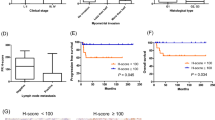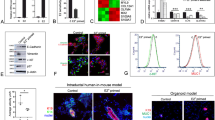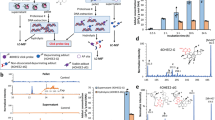Summary
We compared the oestrogenic and anti-oestrogenic properties of the two well-known phyto-oestrogens, genistein and quercetin, on the oestrogen-sensitive breast cancer cell line MCF-7. Genistein exerted a biphasic effect on growth of MCF-7 cells, stimulating at low and inhibiting at high concentrations, whereas quercetin was only growth inhibitory. At doses which did not inhibit cell growth, respectively 5 and 1 μM, genistein and quercetin counteracted oestrogen- and transforming growth factor-α-promoted cell growth stimulation. Furthermore, genistein promoted transcription of the oestrogen-regulated genes pS2 and cathepsin-D, whereas quercetin interfered with the oestrogen-induced expression of the proteins. In in vitro binding experiments, genistein competed with oestradiol for binding to the oestrogen receptor (ER), but quercetin did not. Quercetin and genistein down-regulated cytoplasmic ER levels and promoted a tighter nuclear association of the ER, but only genistein was able to up-regulate progesterone receptor protein levels. In gel mobility assays, ER preincubation with oestradiol or with the two phyto-oestrogens led to the appearance of the same retarded band, excluding differences between the various complexes in binding to the consensus sequence. The data allowed us to conclude that quercetin acts like a pure anti-oestrogen, whereas genistein displays mixed agonist/antagonist properties, and to formulate a hypothesis on the possible mechanism of action of such phyto-oestrogens.
Similar content being viewed by others
Article PDF
Change history
16 November 2011
This paper was modified 12 months after initial publication to switch to Creative Commons licence terms, as noted at publication
References
Adlercreutz, H. (1990). Western diet and western diseases: some hormonal and biochemical mechanisms and associations. Scand J Clin Lab Invest 50: 3–23.
Adlercreutz, H., Godin, B. R., Gorbach, S. L., Hockerstedt, K. A. V. & Watanabe, S. (1995). Soybean phytoestrogen intake and cancer risk. J Nutr 125: 757S–770S.
Akiyama, T., Ishida, J., Nikagawa, H., Watanabe, S., Itoh, N., Shibuy, A. M. & Fukamo, Y. (1987). Genistein, a specific inhibitor of tyrosine-specific protein kinases. J Biol Chem 262: 5592–5595.
Barnes, S., Grubbs, C., Setchell, K. D. R. & Carlson, J. (1990). Soybeans inhibit mammary tumors in models of breast cancer. In: Mutagens and Carcinogens in the Diet, Pariza M Wiley-Liss: New York 239–253.
Barnes, S. (1995). Effect of genistein on in vitro and in vivo models of cancer. J Nutr 125: 777S–783S.
Bates, S. E., McManaway, M. E., Lippman, M. E. & Dickson, R. B. (1986). Characterization of estrogen responsive transforming activity in human breast cancer cells. Cancer Res 46: 1707–1713.
Brown, M. & Sharp, P. A. (1990). Human estrogen receptor forms multiple protein–DNA complexes. J Biol Chem 265: 11238–11243.
Burton, K. H. (1956). A study of the conditions and mechanism of diphenylamine reaction for colorimetric determination of deoxyribonucleic acid. Biochem J 62: 315–323.
Cappelletti, V., Brivio, M., Miodini, P., Granata, G., Coradini, D. & Di Fronzo, G. (1988). Simultaneous estimation of epidermal growth factor receptors and steroid receptors in a series of 136 resectable primary breast tumors. Tumor Biol 9: 200–211.
Cappelletti, V., Ruedl, C., Miodini, P., Fioravanti, L., Coradini, D. & Di Fronzo, G. (1993). Paracrine interactions in co-culture of hormone-dependent and independent breast cancer cells. Breast Cancer Res Treat 26: 275–281.
Cappelletti, V., Miodini, P., Fioravanti, L. & Di Fronzo, G. (1995). Effect of progestin treatment on estradiol- and growth factor-stimulated breast cancer cell lines. Anticancer Res 15: 2551–2556.
Fioravanti, L., Cappelletti, V., Miodini, P., Ronchi, E., Brivio, M. & Di Fronzo, G. (1998). Genistein in the control of breast cancer cell growth: insights into the mechanism of action in vitro. Cancer Lett 130: 143–152.
Horwitz, K. B., Jackson, T. A., Brain, D. L., Richer, J. K., Takimoto, G. S. & Tung, L. (1996). Nuclear receptor coactivators and corepressors. Mol Endocrinol 10: 1167–1177.
Katzenellenbogen, J. A., O’Malley, B. W. & Katzenellenbogen, B. S. (1996). Tripartite steroid hormone receptor pharmacology: interaction with multiple effector sites as a basis for the cell-and-promoter specific action of these hormones. Mol Endocrinol 10: 119–131.
Kühnau, J. (1976). The flavonoids, a class of semi-essential food components: their role in human nutrition. Wld Rev Nutr Diet 24: 117–191.
Lamartiniere, C. A., Moore, J. B., Brown, N. M., Thompson, R., Hardin, M. J. & Barnes, S. (1995). Genistein suppresses mammary cancer in rats. Carcinogenesis 16: 2833–2840.
Lang, D. R. & Racker, E. (1974). Effect of quercetin and F1 inhibition on mitochondrial ATPase and energy-linked reactions in sub-mitochondrial particles. Biochem Biophys Acta 333: 180–186.
Larocca, L. M., Piantelli, M., Leone, G., Sica, S., Teofili, L., Benedetti Panici, P., Scambia, G., Mancuso, S., Capelli, A. & Rancelletti, F. O. (1990). Type-II oestrogen binding sites in acute lymphoid and myeloid leukemias: growth inhibitory effect of oestrogen and flovonoids. Br J Haematol 75: 489–495.
Lock, M. (1991). Contested meanings of the menopause. Lancet 337: 1270–1272.
Markovits, J., Linassier, C., Fosse, P., Couprie, J. & Pierre, J., Jacquemin-Sablon (1989). Inhibitory effects of the tyrosine kinase inhibitor genistein on mammalian DNA polymerase II. Cancer Res 49: 5111–5117.
Martin, P. M., Horwitz, K. B., Ryan, D. S. & McGuire, W. L. (1978). Phytoestrogen interaction with estrogen receptors in human breast cancer cells. Endocrinology 103: 1860–1867.
Ronchi, E., Granata, G., Brivio, M., Coradini, D., Miodini, P. & Di Fronzo, G. (1986). A double-labelling assay for simultaneous estimation and characterization of estrogen and progesterone receptors using radioiodinated estradiol and tritiated Org2058. Tumori 72: 251–257.
Ross, P. D., Norimatsu, H., Davis, J. W. & Yano, K. (1991). A comparison of hip fracture incidence among native Japanese, Japanese Americans and American Caucasians. Am J Epidemiol 133: 801–809.
Scambia, G., Rannelletti, F. O., Benedetti Panici, P., Piantelli, M., Bonanno, G., De Vincenzo, R., Ferrandina, G., Rumi, C., Larocca, L. M. & Mancuso, S. (1990). Inhibitory effect of quercetin on OVCA 433 cells and presence of type-II oestrogen binding sites in primary ovarian tumors and cultured cells. Br J Cancer 62: 942–946.
Scambia, G., Ranelletti, F. O., Benedetti-Panici, P., Piantelli, M., De Vincenzo, R., Ferrandina, G., Bonanno, G., Capelli, A. & Mancuso, S. (1993). Quercetin induces type-II estrogen binding sites in estrogen-receptor-negative (MDAMB-231) and estrogen-receptor-positive (MCF-7) human breast cancer cell lines. Int J Cancer 54: 462–466.
Setchell, K. D. R. & Adlercreutz, H. (1988). Mammalian lignans and phytoestrogens. Recent studies on their formation, metabolism and biological role in health and disease. In: Role of the Gut Flora in Toxicity and Cancer, Rowland IR Academic Press: London 315–345.
Shiu-Ming, K. u. o. (1996). Antiproliferative potency of structurally distinct dietary flavonoids on human colon cancer cells. Cancer Lett 110: 41–48.
Singhal, R. L., Yeah, Y. A., Prajda, N., Olah, E., Sledge, G. S. & Weber, G. (1995). Quercetin down-regulates signal transduction in human breast carcinoma cells. Biochem Biophys Res CommUN 208: 425–431.
Soto, A. M. & Sonnenschein, C. (1985). The role of estrogen on the proliferation of human breast tumor cells (MCF-7). J Steroid Biochem 32: 87–94.
Yamagihara, K., Ito, A., Toge, T. & Numoto, M. (1993). Antiproliferative effects of isoflavones on human cancer cell lines established from the gastrointestinal tract. Cancer Res 53: 5815–5821.
Zava, D. T. & Duwe, G. (1997). Estrogenic and antiproliferative properties of genistein and other fLavonoids in human breast cancer cells in vitro. Nutr Cancer 27: 31–40.
Author information
Authors and Affiliations
Rights and permissions
From twelve months after its original publication, this work is licensed under the Creative Commons Attribution-NonCommercial-Share Alike 3.0 Unported License. To view a copy of this license, visit http://creativecommons.org/licenses/by-nc-sa/3.0/
About this article
Cite this article
Miodini, P., Fioravanti, L., Fronzo, G. et al. The two phyto-oestrogens genistein and quercetin exert different effects on oestrogen receptor function. Br J Cancer 80, 1150–1155 (1999). https://doi.org/10.1038/sj.bjc.6690479
Received:
Revised:
Accepted:
Published:
Issue date:
DOI: https://doi.org/10.1038/sj.bjc.6690479
Keywords
This article is cited by
-
Molecular signaling mechanisms behind polyphenol-induced bone anabolism
Phytochemistry Reviews (2017)
-
You are what you eat, and so are your children: the impact of micronutrients on the epigenetic programming of offspring
Cellular and Molecular Life Sciences (2014)
-
Phytoestrogens inhibiting androgen receptor signal and prostate cancer cell proliferation
Chemical Research in Chinese Universities (2013)
-
Modulation of Paraoxonase 2 (PON2) in Mouse Brain by the Polyphenol Quercetin: A Mechanism of Neuroprotection?
Neurochemical Research (2013)
-
Estrogen-like activity of ethanol extract of Ganoderma lucidum
Journal of Wood Science (2009)



